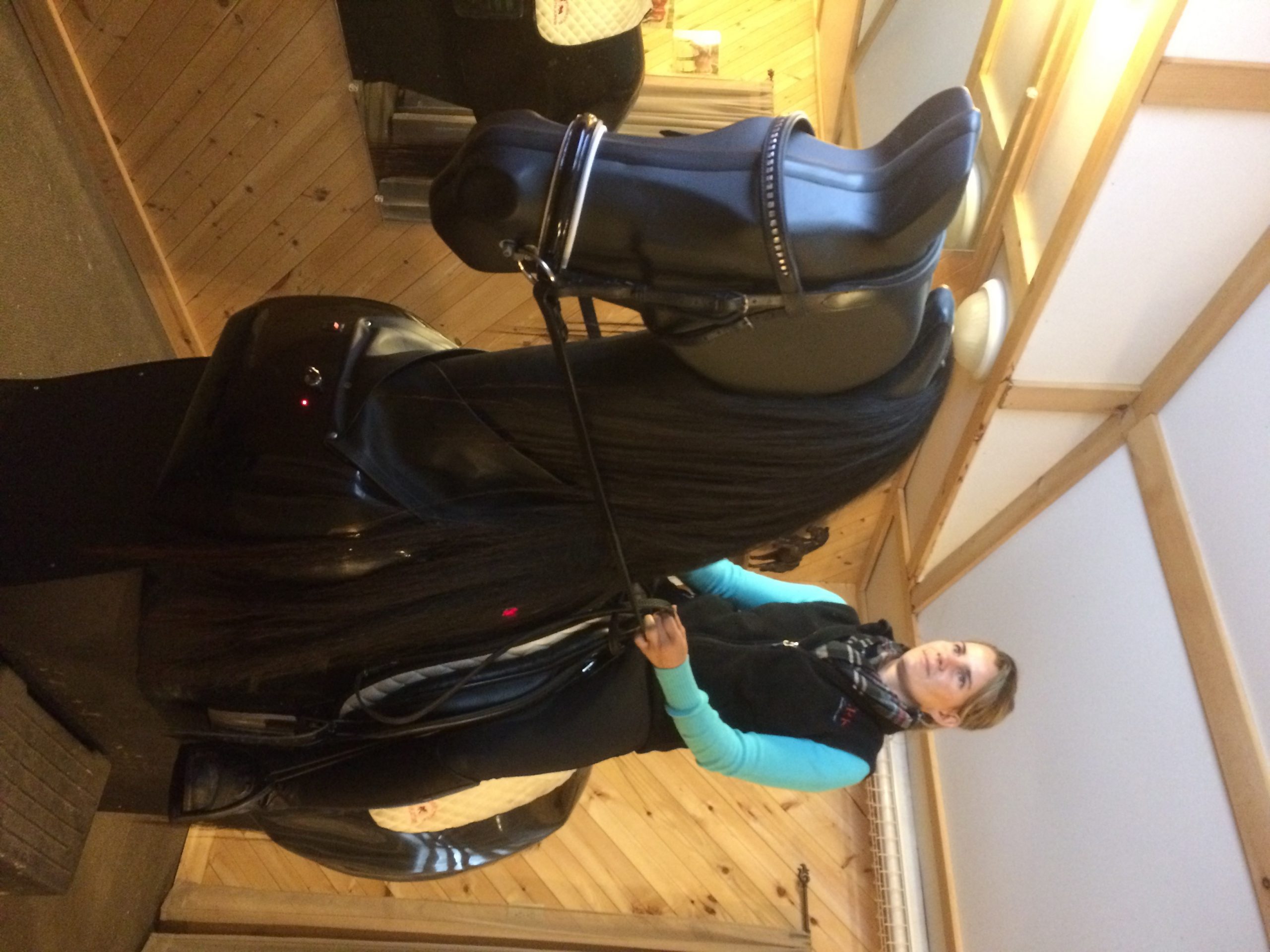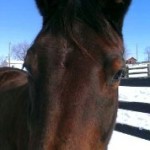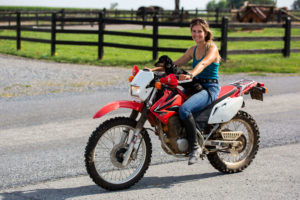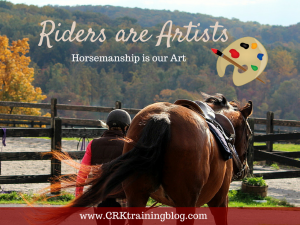Sometimes to improve, we have to first take a step backwards.
Change is rarely easy, and even when we make a change that will eventually help us improve it does not always feel better right away or create an immediate improvement.
In the moment, it will always feel easier to do what is familiar, and specifically to riding, our brain can trick us into feeling as though we are sitting level, using our reins equally, etc.
When we make a change, it may feel awkward, and it is easy to revert to old patterns and second guess if the change is even worth making. But this period of discomfort is necessary and the more we can understand the process through which change happens the easier it becomes to see it through.
In the video below, I will explain three reasons why better may not feel better and how to tell if the change you are making is right.














25 Responses
Just had this conversation with my instructor yesterday! I have been riding forever, since I was 4 yrs old. My body is crooked. Always has been but it is subtle. When a good instructor corrects me I can get straight but it feels awful!! BUT, the response from the sensitive dressage horse I was riding was immediate. She knows when my seat bones and legs are even!! It’s great feedback and positive reinforcement for me because her changes are subtle but I can feel them. SO, I am working on being straight but relaxed…..hard to do when it feels so awkward.
Great message. Thanks for the encouragement. Overusing spoken cues into ineffectiveness is what I’m working on changing right now and goodness it feels awkward once you’re aware of it.
I am trying to hold my hands in front of me and not move all around….also I am trying to learn to keep my legs and heels back and not let them move forward (I’ve ridden Western and neck reining previously). I am so trying to post correctly. It is all so different from Western style and I love the beauty of the English style. It is exciting to be learning something new. Thank you for sharing such good information.
Lisa, those patterns will break and you’ll form new habits the more you practice the new way 🙂 Thanks for sharing!
-Julia Burdy, CRK Training Community Manager
When I took my first lesson from you at Honey Brook Stables Callie, one of the things we worked on was my position in the saddle. I hadn’t really ridden in decades, and came from a “hunt seat” background. This included an arched lower back and slight forward lean in all gaits. When you had me sit up straight and open up my hip angle, it felt strange and scary. It felt like I was leaning backwards. I remember even questioning you a bit, and you took a picture of me on your phone (or mine). It did indeed show that I was sitting up straight, in nice alignment, and not leaning backwards. I believe that not only were my early riding experiences getting in the way of finding a new and better way, it seems to be a “built-in” human response to move toward the fetal position when we are afraid. I also came to realize that leaning forward with a more closed hip angle did not allow me to follow the movement of my horse with my pelvis. When I’m in the right position to follow her movement, my horse moves forward more freely and is much less inclined to brace.
This has been exactly my experience (and problem) riding with correct balance and stability. I remember when I was starting back out 5 years ago, a hunt class I was in the instructor said “get into two-point, stick your backside out and chest out.” It stuck with me! To unlearn that not good arched lower back posture and rebuild my basic skills from what felt like zero, following a confidence draining fall, has been an eleven month process. I was journaling last night that I finally have my confidence back after 11 months to jumping my horse over small jumps, but THIS time my 3 gaits are better than before – I read my horses better – feel their bodies – and find picking up the correct canter lead on a horse’s weaker side is a fun trick to show off to trainers :). I felt if I was going to ride SAFE, I had to tear up the paper and literally start over. That coincided to when I joined Callie’s BRC on this journey. It does feel completely impossible to stop falling forward if my horse makes a sudden speed upchange, I am a total FETAL POSITION instinct person. I’m working hard and not giving up. Enjoy everyone’s shares!
I had watched a video by Steve Halpenny about the “100 mile a month.” In this video, he talks about taking your horse in hand for a walk on trails, down the road, etc. The idea being you introduce them to new trails, roads, etc., for 100 miles a month. I tried this one with my Arab who was very anxious when coming back from a trail ride. It felt very strange, but I was thoroughly amazed how much more attentive he was to me when walking in hand. I walked him home with me on his right side, which he usually tries to avoid, and he was so good and I was able to do lots of half halts and using the word “easy” to slow his walk when he wanted to rush. He was walking so well with me, not pushing, and even relaxing his neck and offered a few sighs and nose flutters. I wouldn’t have expected this kind of reaction. Ground work is really improving his responsiveness and relaxation.
Hi By
I have been watching the Steve Halfpenny videos too and have started my young 3 YO and a 15 YO on the 100 mile a month. We are doing 20 – 30 mins per day and I figure we can take up to 6 mths to get the work done. I have noticed similar results as you – a calmness, sighs and nose flutters – just relaxing. I have also introduced walking with “intention”. Got this gem from a mindset coach.
That is to tell the horse my intention (either out loud or in my head) and then execute it. This is also working to calm my horses, particularly the 3YO. I took him to a new Indoor Arena that he had never seen before and there were horses training, people – lots of activity and his eyes were just about popping out of his head and he was very anxious. Walking with intention changed his posture dramatically – he relaxed, lowered his head and was a lot more attentive to do some ground work. Happy horse walking.
Gaye, I love this suggestion! It is something I actually did with my horse when she was young as well and found it made a huge difference in the bond we have now, great way to expose them to new environments usually a little safer than riding!
-Julia Burdy, CRK Training Community Manager
Where to begin on this question? I feel like a great deal of this journey in learning good horsemanship and riding skills is a series of “Aha!” moments. I am one who has been riding regularly for the past 2 1/2 years, starting as a middle aged adult. Like many when starting out, “correct” felt right when I was actually curled forward (“fetal position”). Over time with help in confidence, feedback from my instructor, videoing myself with a selfie stick periodically, I have been slowly able to make good changes. In my job I spend a lot of time in front of computers, so rounding my shoulders forward with my chin sticking out feels “normal” to me. But my horses respond so much better when I am able to sit up straight with a flat back and what feels like “chin in” to me. More time in the saddle has also meant that my seat and seat-bone awareness is waking up. At times with asking for canter I have been tickled to know that my horse responded to the shift in weight in my seat, rather than simply “outside leg back.” It’s making these improvements that make me feel more “one” with my horse that keeps me coming back!
I really like your suggestion to notice subtle changes in my horse’s way of going. And you have it right that even small changes can feel really awkward! Thanks for this video clip, nice to know other folks may have the same issues with changes.
Callie, a blog you made a while ago was the “heels down” myth. When I was returning to riding after some reconstruction surgeries, I realized some of the seat and legs landmarks I was trying to keep were creating stiffness and counter productive. I love your suggestions that cause me to check and recheck effectiveness. And YES, changing riding skills changes muscle movement and strength. And YES, it hurts mentally and physically for a while.
In my case having a no-stirrup lesson with a lot of rising trot, having only my tights to lean on, has meant a real breakthrough. I learned how it feels to use my tights correctly instead of letting the stirrups carry my weigh with loose legs moving back and front all the time. Since then, each time when I feel that my sit is getting unstable or somehow unlevel, I apply Callie’s body scan and make myself become aware of opening my hip and leaning on my thights, and it helps. What I’ve also found very useful is to have a few lessons without a saddle. In my country (Hungary) it is a quite common way to introduce beginners to riding.
Thanks for sharing Nora! Glad to have you in our community all the way from Hungary 🙂
-Julia Burdy, CRK Training Community Manager
Hi everyone,
For me the biggest change happened in a clinic with Mary Wanless in Belgium quite some years ago. For the first time I learn what ‘sitting straight’ really felt like. Before I was taught to ‘keep my shoulders back and push my chest forward’ and also to ‘keep my hands still’ and ‘elongate my legs more’. The result of all this made it impossible for me to move with the horse and made my body stiff and my back very hollow. When Mary first started to help me sit ‘straight’ it felt like I was bent forwar, while staring at my navel and my arms were dropping forward, and I felt like I was Arnold Schwarzenegger, but unfortunately without his strength!
I’m still struggling with my seat and my back has more tension in it than is good for me and has become almost permanently hollow, but I’ve become aware of it now and keep sending awareness to my body about straightness all the time. After that first awareness lesson with Mary Wannless I have also found Centered Riding and Wendy Murdoch and am enjoying all the good stuff that all these methods are bringing me!
Linda, awareness is the first step to fixing the problem 🙂
-Julia Burdy, CRK Training Community Manager
Hey, totally great summary. And I think it’s hard to overemphasize the significance that “fired is wired” — that the pathways we’ve fired in our brains are the pathways that have become wired in, so they feel the most comfortable (or at least the most familiar), and it takes a lot of commitment and effort at first to fire new pathways–but that’s the learning process. Also, I loved your emphasis on watching how the horse reacts to a change you try. Any advocate of relationship-first horsemanship is always checking in with her horse to see how the horse responds to a change–or really to just whatever is happening in that moment. I noticed a fabulous change in the attitudes that two of my geldings brought to the round pen last week–I had a crazy idea to help them LIKE staying on the rail, so I drizzled hay all around the perimeter of the round pen along the rail. Since my guys are all taught the commands “eat time” and a “head up,” I could move them around the perimeter with very little effort on my part and I could see that they were having FUN, even working in the round pen! I’ll scatter the hay piles farther apart next time and that should liven them up a bit, but what a fun attitude improver. I think it’s a great way to do something playful with your horse.
I grew up being told to “sit straight, shoulders back, heels down”. And I now understand how that creates tension in my body. Since joining CRK Training, I have learned how to move with the horse and relax instead of brace myself. What a difference!! Change is hard, but if I am willing to tolerate the “uncomfortableness”, I ride better and enjoy the rewards!
Exactly Teri! If you just stick with it the benefits will come 🙂
-Julia Burdy, CRK Training Community Manager
This was a most helpful video blog. You have a knack for talking about things that matter to riders — things that we think and do. I am working on posting on the correct diagonal after never paying attention to it. There is a side that feels natural to me and that’s been that ! I figured I was not showing or competing so I just always rose with Asher’s right shoulder. BUT then I decided I needed to fix that and it feels pretty awkward and uncoordinated to post on the correct diagonal when we are traveling to the right. I believe it helps him to balance better. It is still difficult for me and it is still feeling awkward but I trust it will benefit my horse and help my riding.
Callie, this couldn’t have come at a better time. I’ve been riding now for five months after a 40 year break, and I’ve been getting frustrated because I’ve had to change old muscle memory. But recently, things have started to fall into place because I trusted my trainer and watched how my horse behaved as I got better with my communication.? Thank you for explaining the difficulty of changing in such a clear manner.
Great job in noticing the improvement with your horse Christina! Sounds like you are on the right track!
Finally, after finishing college and landing a job, I have my horse back! She’s about 14 years old. I noticed when riding her that we have a lot of reworking to do, to become use to each other’s signals again. I found CRK a couple days ago and I am excited to explore these tips! I believe keeping the tips from this video in mind will really help me stay patient as my horse and I retrain together. I have decided to try to retrain her to use a bitless sidepull bridle. I ride in a Western saddle, but still believe these videos will help us a lot!
Tasheena, welcome back to riding! So glad to have you here, you’ll find hours of free videos here and they will absolutely apply to your western riding 🙂
-Julia Burdy, CRK Training Community Manager
I played polo for a few years then when I moved here to New Zealand polo wasn’t an option for various reasons so I took up dressage and jumping. I would never have thought that I had “learned to ride” when playing polo, I just held on for dear life and missed the ball. But there were certain things you do to play polo that became ingrained and I learned to ride for that particular discipline. So when I started dressage my teacher would say “you’re not playing polo!” when those habits would kick in. I had to consciously *not* do things at the same time as doing new things. It took months to transition to new habits, and even then some polo instincts remained. Interesting process. I’m always amazed at how much riding instructors can see that we aren’t aware of.